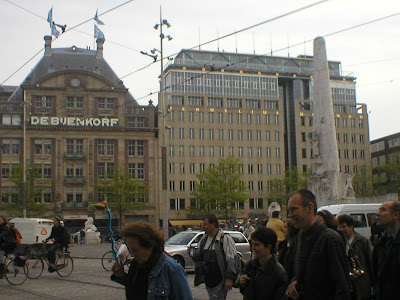trip around Holland
 On my last day in Holland, 31 April, Lalay Noel-Rispens and myself left their home in Gouda and celebrated the annual Queen's day by going out to Utrecht.
On my last day in Holland, 31 April, Lalay Noel-Rispens and myself left their home in Gouda and celebrated the annual Queen's day by going out to Utrecht.

From the sleepy place of Gouda, Lalay and I walked from their home to the central station through the beautiful, quiet roads of Gouda. We walked through the canals.

When we arrived in Utrecht the people were getting ready to celebrate the Queen's day by donning plastic organge crowns.

I also donned the orange royal crown. The color orange is associated with the celebration as the royal family in the Netherlands is associated with the House of Orange.


We first visited the main cathedral in Utrecht.
And walked the streets towards the flea markets where we encountered the statue of Anne Frank of the diary fame.


We got to the places where the open market was in progress and continued our tour of the open market with sugar candy.



The rest of the day we went from shop to shop and viewed the various sights of the riotous celebration.
There were thousands of people lining the canals or riding the barges/yachts.


It was a warn, sunny day so everyone was in a jolly mood.



FLASHBACK:
 From 20 to 30 April 2007, I visited various places in Holland including Hilversum, Purmerend, Amsterdam, Rotterdam and Gouda. Since I've visited Amsterdam various times in the past, I only planned to go visit the Van Gogh Museum once again. Along the route of my walk, I took photos of familiar places like the Central Station square, the old buildings in the downtown area and a ferris wheel right in the downtown area.
From 20 to 30 April 2007, I visited various places in Holland including Hilversum, Purmerend, Amsterdam, Rotterdam and Gouda. Since I've visited Amsterdam various times in the past, I only planned to go visit the Van Gogh Museum once again. Along the route of my walk, I took photos of familiar places like the Central Station square, the old buildings in the downtown area and a ferris wheel right in the downtown area.



 I spent a few days with my friends Ruud and Ineke Hartman at their home in Purmerend. We visited their daughter Pauline in her home near Leiden where we spent time with their grandchildren. There Ruud taught his grandson, Thien, how to plant vegetables and cradled the youngest grandaughter Fern.
I spent a few days with my friends Ruud and Ineke Hartman at their home in Purmerend. We visited their daughter Pauline in her home near Leiden where we spent time with their grandchildren. There Ruud taught his grandson, Thien, how to plant vegetables and cradled the youngest grandaughter Fern.
On 28/29 April, I proceeded to the port city of Rotterdam, where I was to be hosted first by Cora and Grace. Rotterdam is a fascinating city because of the postmodern architecture and infrastructure like the swan bridge and the building that has a "tukod".














I met a number of Filipinos in diaspora who were mainly the wives of Dutch men. They gathered in a church where they as parents planned for the first communion of their children, as facilitated by Grace. Then we went to the house of Lucy and Rene Visser in Rotterdam where we belatedly celebrated the birthdays of Lucy and Leah who are both in this picture.




 It is my first visit to Rotterdam and the city fascinated me with all types of architecture in peaceful co-existence with each other. The swan bridge and the building that seemingly is able to stand upright with the help of a "tukod" are some of the more interesting infrastructure and buildings here, along with the pencil building and the cube houses.
It is my first visit to Rotterdam and the city fascinated me with all types of architecture in peaceful co-existence with each other. The swan bridge and the building that seemingly is able to stand upright with the help of a "tukod" are some of the more interesting infrastructure and buildings here, along with the pencil building and the cube houses.




 It is my first visit to Rotterdam and the city fascinated me with all types of architecture in peaceful co-existence with each other. The swan bridge and the building that seemingly is able to stand upright with the help of a "tukod" are some of the more interesting infrastructure and buildings here, along with the pencil building and the cube houses.
It is my first visit to Rotterdam and the city fascinated me with all types of architecture in peaceful co-existence with each other. The swan bridge and the building that seemingly is able to stand upright with the help of a "tukod" are some of the more interesting infrastructure and buildings here, along with the pencil building and the cube houses. With Rene, Lucy and Grace, we went up the 185 meters of the Euromast and got a panoramic vie of the metropolitan Rotterdam. Designed by the architect Mr. H.A. Maaskant and built in honour of the Floriade - the world's biggest flower exhibition - it was finished in 1960. The view from the tower is truly magnificent.















































